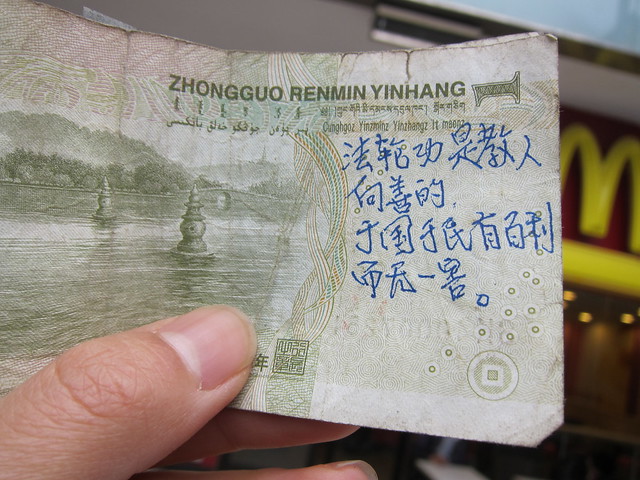Non-digital means of spreading information through paper currency

I bought a tea from a tea stand and this is the 1RMB change that I was given: a hand-written message about fal0n g0ng, explaining that it is a harmless organization that does good things.
I find it fascinating that people are using the natural circulation of paper currency to keep messages alive that would otherwise be difficult to find through the internet or libraries. And of course the 1RMB is the most widely circulated bill in China.
Governments have long used paper currency as a place for spreading propoganda. Benjamin Franklin discovered that the paper currency was a suitable place for the US Colonies to print anti-British propoganda. During the first convening of the Second Continental Congress in 1975, members voted to pass the first resolution to print paper money under the name, "United Colonies." These bills were the first paper currency (according to John Sandrock) to faciliate commerce and reflected anti-British sentiments such as using symbolic motifs and mottos to signify the unity and strength of the US colonies. John Sandrock has written a lot about the history of money and propoganda, and in particular he provides some fascinating history of paper money in China (google his name & download his pdfs, I can't find a website for him!).
If the government can use currency as a form of propoganda, then fal0n g0ng groups have also decided to do the same thing by putting their own hand-written message on them. This makes for an interesting phase of Chinese monetary history.
***
Here's an idea - if any government wants a quick way to make money, I think circulating money with advertisements would be an option. Of course the permanance of ads would be a problem but this could be easily solved with printing ads that fade over time. (I declare a patent on this idea. Who wants to invest in it!?)
Some advertisers have found ways to attach ads to $1 without defacing it or rendering it unusable, such as such NBC's marketing effort in 2005 to give out $115,000 worth of $1 bills affixed with stickers, "What's your Wish," to get people to watch the new show. Christian Mayaud provides some really great analysis and asks some smart questions about the use of paper money as an analog way to spead money. He's fascinated by the economics of spreading messages on paper money, as opposed to more expensives means such as pamphlets. He provides some reasons for this:
- The value of paper currency itself keeps the message from getting thrown out.
- The natural circulation of paper money keeps the message exposure growing in proportion to the number of time a given bill changes hands.
- The variable cost of each exposure is zero.
- Targeting isn’t required.
***
side note - this also makes me think of an interesting site in the US is the Where's George money tracker, which allows you to enter in a serial # to see if others have tracked where the bill was. If people wanted to use money as a propoganda, social movement, or cool project - they could build a digital component to this to extend the information life of the dollar. Then you could track how often a message was getting accessed. The next time I get a dollar with someone's QQ # , I will add them to see who they are.